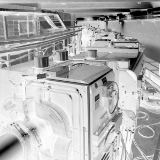Speaker
Ruggero Caravita
(CERN, Universita degli Studi di Genova)
Description
The direct measurement of Earth's gravitational acceleration on a purely antimatter system has been a dream of experimental particle physics for more than twenty years, since the first antiproton cooling attempts at CERN's Low Energy Antiproton Ring. The efficient production of antihydrogen atoms in traps at CERN's Antiproton Decelerator in 2002, opened a possibility to perform such measurement of a neutral antimatter system, overcoming the difficulties experienced with charged antiparticles. This is the ambitious objective of the AEgIS collaboration: perform a precise and direct gravity measurement on cold antihydrogen.
A survey of the performances of the catching traps in the last run with antiprotons, positrons and electrons will be presented. Efficient catching of antiprotons and cooling by electrons was achieved in a Malmberg trap by controlling the density of the electron plasma with the rotating wall technique. Centrifugal separation of the two particle plasma was observed, setting some coarse limits on the temperature of the resulting antiproton plasma.
Finally, optimal transfer conditions for positrons were studied in detail: stable transfer efficiencies close to 100% were achieved between the 0.1 T buffer-gas accumulator to the 4.46 T ultra-high vacuum catching trap by careful tuning of transfer parameters.
Author
Ruggero Caravita
(CERN, Universita degli Studi di Genova)
